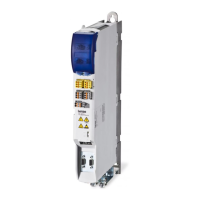Installation
Electrical installation
4.2.2 Controller protection
4-21
L
EDSVS9332S-B EN 3.0
4.2.2 Controller protection
Stop!
The controllers contain electrostatically sensitive components.
z Prior to assembly and service operations, the personnel must be free of electrostatic charge:
– Discharge by touching the PE fixing screw or another earthed metal part in the control
cabinet.
z Length of the screws for connecting the shield cable/shield sheet for the types 9327 to 9332:
<12mm
z Controller protection by means of external fuses. ( 3-7)
z Protect unused control inputs and outputs with plugs or covers (included in the scope of
supply) for the Sub-D inputs.
z Frequent mains switching may lead to an overload of the internal starting current limitation. If
the mains is switched cyclically, the controller can be switched on every three minutes as a
maximum.
z The controllers 9324, 9326, 9328 and 9329 must only be operated with the appropriate mains
filters. ( 3-8)
z In case of condensation, connect the controller to the mains voltage only after the visible
humidity has evaporated.
4.2.3 Motor protection
z Extensive protection against overload:
– By overcurrent relays or temperature monitoring.
– We recommend to use a PTC thermistor or thermal contact (NC contact) for motor
temperature monitoring. (Lenze three-phase AC motors are fitted with thermal contacts as
standard)
– PTC thermistor or thermal contact (NC contact) can be connected to the controller.
z Only use motors with an insulation suitable for the inverter operation:
– Insulation resistance: Max. û = 1.5 kV, max. du/dt = 5 kV/μs
– Lenze three-phase AC motors are designed for inverter operation.
– When using motors with an insulation resistance which is not suitable for the inverter
operation, please contact your motor supplier.

